|
|
piccadilly
Introduced in 1932 to light Piccadilly Circus. It was a post-top unit employing a
large diffusing globe of "Nelite" glass permitting the use of large lamps withouth glare. Originally
took a 1500W GLS lamp.
|
|
Piccadilly
|
1500 GLS
|
BC
|
Post Top
|
No Gear
|
1932 catalogue
|
|
|

|
london / london major
Introduced in 1932 as the "London" Lantern and employs the Ediswan Prismatic Refractor with pressed glass outer
globe and provision for exterior focussing.
These lanterns provide a non-axial light distribution. It is equipped with a prismatic refractor globe
with internal prisms, the outer surface, with the exception of the path side, being quite smooth, thus reducing to a minimum
the collection of dust and greatly facilitating cleaning. The head embodies a drip proof wiring
chamber housing a porcelain connector. At the top is fitted an aligning flange tapped 1", which
ensures the lantern will hang plumb. The internal reflector is finished white vitreous enamel.
Takes Incandescent or Mercury Discharge Lamps. For Group A roads. For side or centre road mounting.
Also available with symmetrical distribution
By 1939 the London range (including a London Major, Medium and Minor) are the
general utility units of the bowl refractor type for all sizes of vertically burning
mercury discharge lamps or gas-filled incandescent lamps.
|
|
London Major
|
500W GLS
250-400W MA/V
|
GES
|
Top Entry
|
No Gear
|
1932 catalogue
1937 advert
1937 programme
1939 advert
1944 journal
1945 advert
1945 programme
|
|
|
|
|
northbury
Designed for use with the "Escura" mercury vapour discharge
lamp and also with regular incandescent lamps. A reflector system
gives full control of the light in both the vertical and horizontal
planes, thus ensuring correct distribution for bends and gradients
as well as for straight roads. The light emission normally wasted
above the horizontal is redirected onto the road surface ensuring
high peak candle power and by lowering the intensity between
80° and 90° glare is reduced and visibility consequenty
improved.
|
|
Northbury
|
??? GLS
??? MA/V
|
GES
|
???
|
No Gear
|
1936 Journal
|
|
|
|
|
stepney
This lantern embodies a simplified form of reflector system on the same principle as that
used by the Northbury lantern and gives full light control in both vertical and horizontal planes.
It also has a non-axial light distribution. The body and canopy are constructed of heavy guage copper
and is fitted with a cast-iron cap, which forms a drip-proof wiring chamber and houses a shrouded terminal block.
The optical system consists of a chromium-plated reflector which forms part of the canopy, and below,
a pair of silvered glass reflectors mounted on the bottom hinged panel of a body, allows easy access to the
interior for cleaning and lamp renewal. The body is glazed with diffusing glas panels.
|
|
Stepney
|
250-400W MA/V
|
GES
|
Top Entry
|
No Gear
|
1937 programme
|
|
|
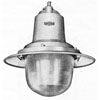
|
london medium
Refractor Lantern for use with Incandescent or Mercury Discharge Lamps. For side road mounting. Also available
for symmetrical distribution.
|
|
London Medium
|
300-500W GLS
125 MB/V
|
ES
3BC
|
Top Entry
|
No Gear
|
1939 advert
1944 journal
1945 advert
1945 programme
|
|
|
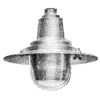
|
london minor
Refractor Lantern for use with Incandescent or Mercury Discharge Lamps. For the lighting of Group B roads.
For side or centre of road mounting. Also available for asymmetrical distribution.
|
|
London Minor
|
100-200W GLS
80-125W MB/V
|
BC
3BC
|
Top Entry
|
No Gear
|
1938 advert
1939 advert
1944 journal
1945 advert
1945 programme
|
|
|

|
granby
Diffuser-Refractor Lantern for use with Incandescent or Mercury Discharge Lamps. For the lighting of Group B roads.
For side or centre road mounting.
|
|
Granby
|
100-200W GLS
80-125W MB/V
|
BC
3BC
|
Top Entry
|
No Gear
|
1938 advert
1939 advert
1944 journal
1945 programme
|
|
|
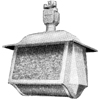
|
newland
Refractor-Reflector Lantern for use with horizontally burning Mercury Discharge Lamps. For the lighting of
Group A roads. Light control by means of a combination of prismatic
refractors and reflectors, care being taken to reduce the candle power at angles
approaching the horizontal inorder to minimise glare. Lamp and optical
equipment are totally enclosed within the lantern. There are only three glass
panels, the area exposed for the deposit of dirt is reduced to a minimum and
maintenance is simple. The lantern is constructed from aluminium alloy and
iron castings and is fitted with a combined aligning union and drip-proof junction
box, making installation easy.
|
|
Newland
|
250-400W MA/H
|
GES
|
Top Entry
|
No Gear
|
1938 advert
1939 advert
1944 journal
1945 programme
|
|
|

|
cromer
The lantern is of the open type and are of simple, robust design,
aluminium alloy and iron castings being employed in their construction. The
light control is by means of single piece prismatic refractors. Two sizes are
available (for Group A and Group B).
|
|
Cromer
|
45-600W SO/H
|
BC
|
Top Entry
|
No Gear
|
1939 advert
|
|
Cromer
|
85-140W SO/H
|
BC
|
Top Entry
|
No Gear
|
1939 advert
|
|
|
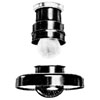
|
arp
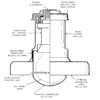 Complies with BS/ARP 37. For wartime use. The lantern is a precision lighting unit, with vitreous enamelled components designed espressly to
maintaininitially efficiency without constant maintenance. Therefore the use of wire gauze, finely pierced metalor glass
reducing screens have been avoided. The fitting contains two refelctors, constructed as a unit on theover-lamp principle,
the light gap being masked to adjust light output accordingly to mounting height. Each fitting is clearly marked indicating
the mounting height at which it should be fixed with a 15W pearl lamp. The reflector and cup forming the lower part of
the fitting are so fixed that they can be quickly detached for lamp renewal and cleaning. A die-cast and tapped top at
the head of the fitting will make it possible to fix direct into existing lanterns without the use of special adaptors.
Where this is found impracticable, a special type of adaptor is available for fitting into BC, ES or GES lampholders.
Complies with BS/ARP 37. For wartime use. The lantern is a precision lighting unit, with vitreous enamelled components designed espressly to
maintaininitially efficiency without constant maintenance. Therefore the use of wire gauze, finely pierced metalor glass
reducing screens have been avoided. The fitting contains two refelctors, constructed as a unit on theover-lamp principle,
the light gap being masked to adjust light output accordingly to mounting height. Each fitting is clearly marked indicating
the mounting height at which it should be fixed with a 15W pearl lamp. The reflector and cup forming the lower part of
the fitting are so fixed that they can be quickly detached for lamp renewal and cleaning. A die-cast and tapped top at
the head of the fitting will make it possible to fix direct into existing lanterns without the use of special adaptors.
Where this is found impracticable, a special type of adaptor is available for fitting into BC, ES or GES lampholders.
|
|
???
|
15W GLS
|
BC
|
Top Entry
|
No Gear
|
1940 Journal
|
|
|
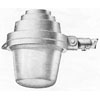
|
siden
Developed in 1944 to meet the demand for a side entry lantern. It has exceptionally robust mechanical features
and the side entry device permits accurate alignment of the fitting in both the horizontal and vertical planes.
Ample room is allowed for wiring and maintenance can be effected with ease.
|
|
???
|
500W GLS
250-400W MA/V
|
GES
|
Side Entry
|
No Gear
|
1944 Journal
|
|
|
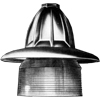
|
|
|
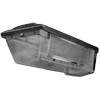
|
ssa/1
Totally enclosed plate refractor lantern of
unique design for use with 85W or 140W sodium
discharge lamps. It consists of a cast canopy
of corrosion resisting aluminium alloy and a Perspex
enclosing bowl with precision cut Perspex refractor
plates sealed to the inside so that the outside is
smooth. The enclosing bowl slides open to give easy
access to the interior. Felt runnings ensure smooth
action and as the bowl is firmly supported in all
positions, maintenance staff have both hands free
for cleaning and relamping. A single knurled screw
secures the slide in its closed positon. Water
repellent, insect proof felt gaskets make the lantern
completely weatherproof and a water baffle in the
socket prevents the ingress of moisture from
the suspension arm.
|
|
SSA/1
|
85W-140W SO/H
|
BC
|
Side Entry
|
No Gear
|
1953 advert
|
|
|
|
|
|
|
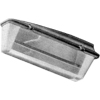
|
|
|



